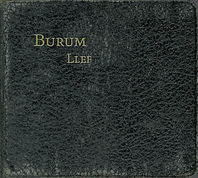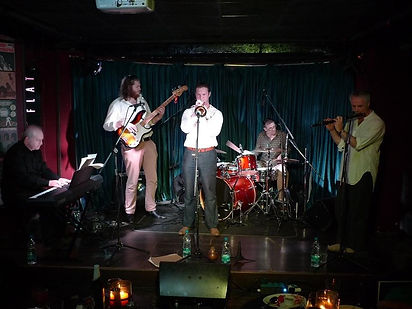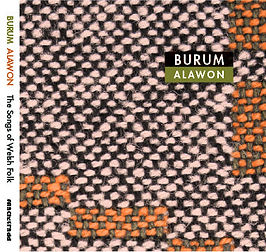
Adolygiadau o Eneidiau / Reviews of Eneidiau

BURUM
Arguably operating in a field of one, Burum has fused left-of-centre jazz and Welsh folk for about 15 years, and not only have they become more interesting with each release, their latest album Eneidiau impresses me more with every listen. The addition of Patrick Rimes to the ensemble has offered a new angle: credited with “various whistles” and, especially, bagpipes, he brings a more broadly Celtic air to pieces otherwise coloured by Tomos Williams’ gossamer trumpet, Aidan Thorne’s inscrutable bass plucks and Dave Jones’ piano ripples, to name a few elements. Trad French and Jewish melodies also crop up, with the influence of Miles Davis and Keith Jarrett – both already in Burum’s DNA, I fancy – cited to boot. Recommended!
Wales Arts Review
Burum - Eneidiau
Read the full Review by Gary Raymond
Two competing questions crop up in my mind when listening to the progress of Welsh jazz as it moves in the stewardship of players like Tomos Williams. First is this: when is a good time to move on from the influence of Miles Davis? Second: why should you at all? Williams, with his band Burum (but also with his other projects) takes Davis with him no matter where he’s wandering (if wandering doesn’t conjure up too many connotations of guileless listlessness). Williams is no such bandleader. If you’ve ever seen him live, you’ve seen a man of intense focus, of a quiet ferocity of vision, and, it mustn’t be left out, a man who resolutely enjoys his music, his band, and his position on the stage. Burum now are a fixture on the jazz circuit, and anything coming from that camp is to be hotly anticipated. Eneidiau is their fourth album, and as with the previous three, is not just an extension of a catalogue but is part of an evolving journey for the sound of the band and the preoccupations of its leaders (I should say Burum is the band of Tomos Williams and his brother Daniel on trumpet and tenor sax respectively). Burum is the Welsh word for yeast, and it seems the growth of the band, then, is an intentional organic measurement and not just the way things have turned out.
The most prominent move on Eneidiau is the recruitment of Patrick Rimes, a multi-instrumentalist whose bagpipes and various whistles break out into the soundsphere like the kicking over of the buffet table at a wedding. And things were going so well; now comes the folkloric razzle dazzle. Rimes’ contributions pierces that Miles Davis vibe, and it’s both shocking and entirely welcome. Miles would have approved, no doubt. Opener, a cool-as-shit rendition of “Cariad Cywir” that brings to mind immediately the high-water marks of other scene-setters of the golden age like “Cool Struttin’” or “Prince of Darkness”. The Williams boys have taken the central riff from the Welsh folk song and twisted it into something smoky, all dark glasses at night and toe-tapping of Italian shoe leather.
Eneidiau is a fine album, replete with gorgeous textures and that irreplaceable vibe of a band playing in a room together. The vision for the material, the arrangements of it, and the intellectual grasp of it all by the musicians, is of the highest quality. Next – indeed, soon – for Tomos Williams, is a new record from his Wales/India project, Khamira – an album and tour of Wales, which will promise just as much as Burum consistently manages to do.
BURUM - ENEIDIAU
Ian Mann
Read the full comprehensive review here: JazzMann Review
A very welcome addition to the Burum canon. Nobody else sounds quite like them.
The Welsh sextet Burum specialises in what must be a unique combination of Welsh folk music and jazz. Co-led by brothers Tomos and Daniel Williams the band was formed in 2007 and has since carved out its own distinctive musical niche through the brothers’ jazz arrangements of traditional Welsh folk tunes and hymns.
“Eneidiau”, meaning “Souls” or “Spirits” is the fourth album from Burum and follows in the wake of the acclaimed “Alawon” (meaning “Tunes”) from 2007, the excellent “Caniadau” (“Songs”) from 2012 and the more recent “Llef” (“The Cry”) from 2016. Both “Caniadau” and “Llef” are favourably reviewed elsewhere on the Jazzmann web pages as is an excellent live performance by the band at the 2014 Brecon Jazz Festival. I’ve also enjoyed other live performances from the group in the less formal setting of the Queens Head pub in Monmouth, the latest of these being in July 2022 and the official launch of the “Eneidiau” album. Largely concentrating on material from the new recording the sextet delivered a highly charged performance that clearly delighted the audience, with drummer Mark O’Connor in particularly scintillating form as he and Thorne created a highly propulsive platform for the front line soloists, including Burum’s latest recruit, Patrick Rimes on the Welsh bagpipes and a variety of flutes and whistles....
....The album commences with “Cariad Cywir” (“True Love”), which in fact turns out to be a tale of unrequited love. Burum’s arrangements typically combine folk melodies with the kind of modal jazz pioneered by Miles Davis and John Coltrane. This piece features the appealing blend of the Williams brothers’ trumpet and sax, the alternating Bill Evans / McCoy Tyner piano stylings of Dave Jones and the subtly propulsive rhythms of Thorne and O’Connor. But the most distinctive component is Rime’s pipes as he shares the solos with Tomos Williams’ trumpet. O’Connor is a highly musical drummer and one passage brings his skins to the fore, his sticks dancing nimbly around the kit in the most melodic of drum features.
“Suo Gan” translates as “lullaby” and this piece functions in this capacity, albeit in a manner inspired by the meditative music of Alice Coltrane and Pharaoh Sanders. The melody is only alluded to in an atmospheric ‘free jazz’ performance that features the sounds of reeds, brass, piano, bowed bass and shimmering cymbals. Rimes features on whistle, bringing an air of Celtic mysticism into the mix that combines well with the ‘spiritual jazz’ elements...
The album concludes with the near fifteen minute “Myn Mair” (“Oh Mary”), which takes its title from a prayer delivered at the time of death and pleading for the release of a friend’s soul from purgatory. The melody dates back to the 16th century and the Catholic Church in Wales at that time.
Musically the piece draws inspiration from the 1976 Keith Jarrett album “The Survivor’s Suite” and from the music of the late, great Polish trumpeter and composer Tomasz Stanko.
The performance is almost entirely improvised and commences with the melancholic sounds of Rimes’ flutes and whistles, subsequently joined by O’Connor’s drum colourations, Thorne’s bowed bass and eventually brass and reeds with Daniel’s tenor eventually assuming the lead. Essentially this is a ‘free jazz’ performance but one that embraces the same kind of spirituality that distinguishes “Suo Gan” on Side A. It’s also similar in feel to the Jarrett album that helped to inspire it. Rimes’ flutes return as the sextet continue to improvise around the folk melody, grounded by Thorne’s bass. Jones keeps a low profile, only entering the fray at a comparatively late point in the proceedings as he exchanges melodic phrases with Rimes and the Williams brothers.
Pressed on very high quality vinyl “Eneidiau” is a very welcome addition to the Burum canon. During the course of its fifteen year existence the group has established an impressive rapport with the core ‘jazz quintet’ of Williams, Williams, Jones, Thorne and O’Connor there from the beginning. Rimes has fulfilled the imposing task of fitting into Ceri Rhys Williams’ shoes with considerable aplomb and it’s his multi-instrumental skills on pipes, flutes and whistles that help to make this sextet so unique. Nobody sounds quite like Burum, so to paraphrase Daniel Williams let’s hope their dance will also continue for some time yet.

JAZZ JOURNAL
Adolygiad o 'Llef' yn y cylchgrawn Jazz Journal, Medi 2016
Review of 'Llef' in the September 2016 issue of Jazz Journal magazine
MUSICIAN MAGAZINE
Adolygiad byr, ond caredig iawn o “Llef’ yn y Musician magazine.
Wele isod:
A short, but sweet review of ‘Llef’ from the Musician magazine, “compelling and remarkable”


Review of ‘Llef’ by Ian Mann at the jazzmann.com
Read the full lengthy review here
The band’s approach sounds as fresh and inventive as ever. “Llef” is a worthy addition to the Burum catalogue. ****
Burum is a sextet co-led by the Williams brothers Tomos (trumpet) and Daniel (tenor sax). Originally from Aberystwyth the brothers are now based in Cardiff and the Burum line up includes some of the finest jazz musicians on the South Wales scene in the shapes of pianist Dave Jones, bassist Aidan Thorne and drummer Mark O’Connor. The band is completed by Ceri Rhys Matthews, a folk musician who specialises on the wooden flute. Matthews is very much the ‘wild card’ of the group and his contributions do much to give Burum their unique group sound...
...The majority of the arrangements on the new album are by Tomos Williams beginning with a forty five second snippet of the title track, a brief chorale featuring the unique front line of trumpet, tenor sax and wooden flute. Burum took their inspiration for this from Thelonious Monk, who opened his 1957 album “Monk’s Music” with a fifty five second version of “Abide With Me”. Meanwhile “Llef” bookends this new Burum album with a full six and a half minute performance of the piece at the end of the record, which I’ll address more fully later.
The succinct but charming intro leads into the playful “Titrwm Tatrwm”, which translates as “Pitter Patter” and references the seemingly universal folk custom of tapping upon a sweetheart’s window to gain access. The music is introduced by a roll of O’Connor’s drums before settling on an arrangement that owes something to the modal jazz of the 1960s. If John Coltrane had been born in Wales maybe he would have sounded something like this. The piece is notable for a rumbustious piano solo from Dave Jones which reflects his love of the playing of Coltrane’s one time pianist McCoy Tyner. Daniel Williams also impresses on tenor as he adopts the John Coltrane role while the overall ensemble sound is powerful and convincing with O’Connor’s colourful and flexible drumming helping to drive the arrangement....
...Daniel Williams takes over the arranging duties on the hymn like “Y Gwydr Glas”, which variously translates as “Blue Glass” or “The Window Pane”, another song from the same folk tradition as the earlier “Titrwm Tatrwm”. It’s an absolutely gorgeous melody that is enhanced by the sensitive arrangement and performance with delightful cameos from Thorne, Daniel Williams and Tomos Williams followed by a surprisingly stirring group outro...
Finally comes the extended version of “Llef” itself which begins with that opening chorale before opening out into a spacious arrangement with the lonely ring of Tomos Williams’ emotive, Miles Davis styled trumpet leading off the solos. Jones follows with a flowingly lyrical piano solo before the now familiar initial theme returns.
Burum describe their creative process as “making new music with old melodies”. “Llef” continues the good work that began with “Alawon” and continued through “Caniadau” and the band’s approach sounds as fresh and inventive as ever. The Welsh folk tradition seems to offer an unending supply of memorable melodies for the group to explore and “Llef” is a worthy addition to the Burum catalogue, there are some great tunes here. The only disappointment is that this album doesn’t feature Matthews playing the Welsh bagpipes, something that he did to great effect on “Caniadau”.
In the live environment the members of Burum stretch out on these tunes at greater length, their performances are emphatically jazz events with an emphasis on collective improvisation and strong soloing. The remaining dates on their current tour of Wales are listed below. In the meantime “Llef” and its predecessors are highly recommended.
ADOLYGIADAU O BURUM YNG NGWYL JAZZ ABERHONDDU 2014
REVIEWS OF BURUM LIVE AT THE BRECON JAZZ FESTIVAL 2014
Darllenwch yr adolygiadau isod:
Read the review of the concert by Access All Areas Music,
"Burum blends traditional Welsh folk songs with modern jazz, in its own innovative style. The band is timeless, creative and a little bit different."
Read the review of the concert by jazzmann.com
"Burum were very well received by the audience at Christ College, their jazz interpretations of these timeless melodies were effective, absorbing and often very beautiful...In the world of jazz/folk crossovers Burum have carved out a unique niche for themselves and their reputation within both the jazz and folk communities should continue to grow."


REVIEW OF BURUM LIVE IN BANGALORE, from the Deccan Herald, 12th March 2014
It was a delightful evening of jazz and Welsh folk music at BFlat recently, when Burum, a unique jazz quintet from Wales and the UK, took the stage.
Modern in their sound but rooted in their style, the originally six-member band gave the audience a night to remember.
The five members on the India tour included Tomos Williams on trumpet, Ceri Rhys Matthews on bagpipes and wooden flute, Dave Jones on piano, Aidan Thorne on bass and Mark O’Connor on drums. What was unique was that despite the tunes being picked up from Welsh folk traditions, the band’s repertoire merely drew inspiration from it while adding their own interpretations and improvisations to it.
At the gig too, the music was mostly improvised, which the band seemed to enjoy thoroughly. They were also seen smiling among themselves. The set list comprised of mostly Welsh compositions, including ‘Ar Ben Waun Tredegar’ and ‘Hiraeth am Feirion’.
Being a jazz band, the saxophone was missed quite a bit, but the band informed that this gap was because their saxophonist Daniel Williams was unable to make the tour. Still, the Welsh bagpipes and wooden flute created an enchanting soundscape while the trumpet and bass had minds of their own. The drummer too deserves a mention keeping exceptional timing as is necessary in jazz.
“It was very interesting to check out ‘Burum’ and I hope that the venue calls more such bands in the future. What I enjoyed was how tight they sounded even without the saxophone, which I missed initially but forgot about by the end. The way they interacted amongst each other reflected their years of experience. I’m glad I came for the show,” said Ashwin, who attended the concert.
Roopa, another audience member, said that she enjoyed the trumpet the most. “I loved the ease with which the trumpet was played. In fact, all the instruments were played with seemingly no effort. And the flute often had an Indian vibe to it, making it world music for me more than jazz,” she shared.
The band too enjoyed performing and appreciated the fact that Bangalore crowd knew their music well. “We’ve played three gigs already in Mumbai and New Delhi and each one was very different. This was our first club gig in India and it was lovely. The sound was great and the audience was well-versed with jazz,” said Tomos Williams, who played the trumpet.
ADOLYGIADAU O / REVIEWS OF 'CANIADAU'
(Recordiau Bopa 001)
“Hyfryd iawn” - Huw Stephens, C2, BBC Radio Cymru
“Wonderful, evocative music” - Adam Walton, BBC Radio Wales
Read the jazzmann.com review of ‘Caniadau’ ****
An impressive piece of work with some excellent playing from all six members of what is effectively a Welsh "supergroup". Jazz/folk fusions don't always work but on the whole this succeeds brilliantly

Adolygiad gan Lefi Gruffudd yn Barn
“Gyda chymaint o artistiaid yn ailddarganfod ac yn ailddehongli caneuon gwerin Cymreig yn ddiweddar, yn cynnwys 9Bach, Cerys Matthews a Cowbois Rhos Botwnnog, mae hi’n braf gweld Burum yn mynd â phethau gam ymhellach mewn CD o’r enw Caniadau sydd wedi cael ei labelu dan ‘Gwerin-Jazz’.
O dan arweiniad y ddau frawd Daniel a Tomos Williams (sacsoffon a thrwmped) mae’r casgliad yma’n eich tywys ar daith leddf sydd gymaint o dan ddylanwad y cerddor jazz Miles Davis â’r traddodiad gwerin Cymraeg…
Dyma gasgliad gwerth chweil sy’n rhoi cyfle gwych i ail-fyw rhai o’n halawon hyfrytaf ac sydd hefyd yn mynd â chi ar daith bellach dan ofal offerynwyr meistrolgar mewn cynhyrchiad di-fefl.”

Adolygiad / Review of ‘Alawon: The Songs of Welsh Folk’ (fflach:tradd)
Taplas - August 2007
Here we have the classic jazz line-up: trumpet, sax, piano, bass and drums. On trumpet is Tomos Williams, whose playing is such a distinctive feature of Fernhill, also included is the bag-hornpipe, played by Ceri Rhys Matthews. This instrument is not normally associated with jazz improvisation, but the interpretation of Marwnad yr Ehedydd is really something quite special. Although this is predominantly a jazz album, the melodies used are well-known traditional Welsh tunes…and their performances show a complete understanding of and love for the traditional music of Wales.
With their performance of Ar lan y Môr, the whole sentiment of the song is rediscovered in their tender and gentle interpretation. It will melt your heart. Again they reach the very essence of the song with Yr Eneth Glaf.
Burum means yeast. They take familiar ingredients and breathe new life into them. This is indeed a heady-brew. Very highly recommended.